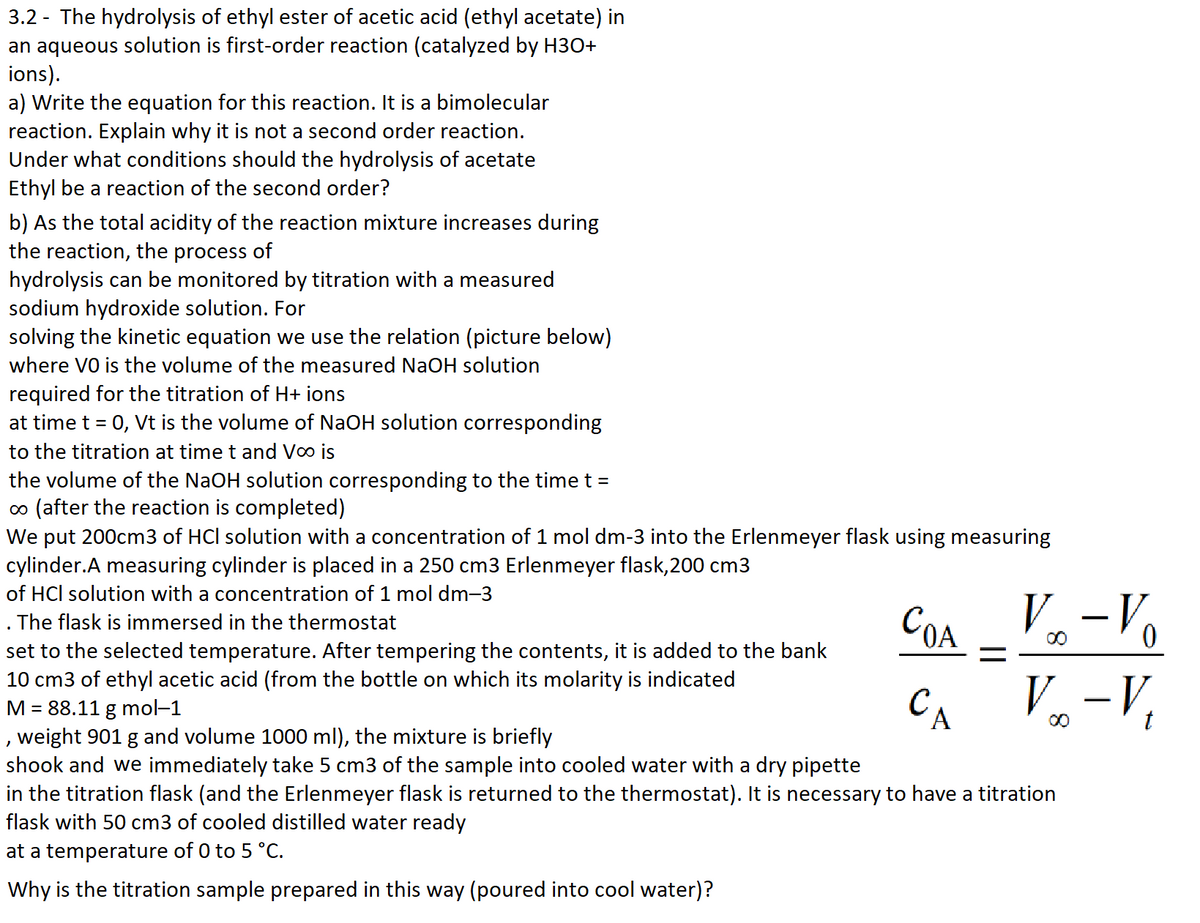General Chemistry - Standalone book (MindTap Course List)
11th Edition
ISBN:9781305580343
Author:Steven D. Gammon, Ebbing, Darrell Ebbing, Steven D., Darrell; Gammon, Darrell Ebbing; Steven D. Gammon, Darrell D.; Gammon, Ebbing; Steven D. Gammon; Darrell
Publisher:Steven D. Gammon, Ebbing, Darrell Ebbing, Steven D., Darrell; Gammon, Darrell Ebbing; Steven D. Gammon, Darrell D.; Gammon, Ebbing; Steven D. Gammon; Darrell
Chapter13: Rates Of Reaction
Section: Chapter Questions
Problem 13.22QP
Related questions
Question

Transcribed Image Text:3.2 - The hydrolysis of ethyl ester of acetic acid (ethyl acetate) in
an aqueous solution is first-order reaction (catalyzed by H3O+
ions).
a) Write the equation for this reaction. It is a bimolecular
reaction. Explain why it is not a second order reaction.
Under what conditions should the hydrolysis of acetate
Ethyl be a reaction of the second order?
b) As the total acidity of the reaction mixture increases during
the reaction, the process of
hydrolysis can be monitored by titration with a measured
sodium hydroxide solution. For
solving the kinetic quation we use the relation (picture below)
where VO is the volume of the measured NaOH solution
required for the titration of H+ ions
at time t = 0, Vt is the volume of NaOH solution corresponding
to the titration at time t and Voo is
the volume of the NaOH solution corresponding to the time t =
co (after the reaction is completed)
We put 200cm3 of HCl solution with a concentration of 1 mol dm-3 into the Erlenmeyer flask using measuring
cylinder.A measuring cylinder is placed in a 250 cm3 Erlenmeyer flask,200 cm3
of HCI solution with a concentration of 1 mol dm-3
. The flask is immersed in the thermostat
set to the selected temperature. After tempering the contents, it is added to the bank
10 cm3 of ethyl acetic acid (from the bottle on which its molarity is indicated
M = 88.11 g mol-1
, weight 901 g and volume 1000 ml), the mixture is briefly
shook and we immediately take 5 cm3 of the sample into cooled water with a dry pipette
in the titration flask (and the Erlenmeyer flask is returned to the thermostat). It is necessary to have a titration
flask with 50 cm3 of cooled distilled water ready
at a temperature of 0 to 5 °C.
Why is the titration sample prepared in this way (poured into cool water)?
СОА
CA
V₂-V₁
Vo
V-V
Expert Solution
This question has been solved!
Explore an expertly crafted, step-by-step solution for a thorough understanding of key concepts.
Step by step
Solved in 3 steps

Knowledge Booster
Learn more about
Need a deep-dive on the concept behind this application? Look no further. Learn more about this topic, chemistry and related others by exploring similar questions and additional content below.Recommended textbooks for you

General Chemistry - Standalone book (MindTap Cour…
Chemistry
ISBN:
9781305580343
Author:
Steven D. Gammon, Ebbing, Darrell Ebbing, Steven D., Darrell; Gammon, Darrell Ebbing; Steven D. Gammon, Darrell D.; Gammon, Ebbing; Steven D. Gammon; Darrell
Publisher:
Cengage Learning

General Chemistry - Standalone book (MindTap Cour…
Chemistry
ISBN:
9781305580343
Author:
Steven D. Gammon, Ebbing, Darrell Ebbing, Steven D., Darrell; Gammon, Darrell Ebbing; Steven D. Gammon, Darrell D.; Gammon, Ebbing; Steven D. Gammon; Darrell
Publisher:
Cengage Learning